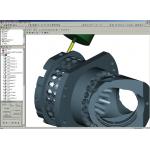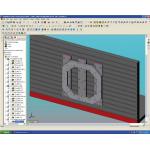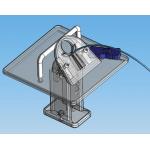Latest News
November 1, 2006
By Mark Driscoll
To integrate or not to integrate? That is the question manufacturers, machine shops, and production groups face regarding the use of CAD and CAM technologies. Many product developers have chosen to implement integrated CAD/CAM solutions to not only improve productivity, spark innovation, and accelerate time to market, but also because failing to do so would put them at a distinct competitive disadvantage and maybe even out of business.
Dennis Waite, shop manager of Deka Research & Development, a contract machine shop in Manchester, NH, that uses the integrated SolidWorks-SolidCAM CAD/CAM solution, said, “We have determined that we cannot afford to operate without an integrated CAD/CAM system. We realize benefits at almost every phase of the process, resulting in operating cost savings that simply make us more competitive.”
Increased Efficiency
An integrated CAD/CAM solution uses CAD modeling technology and a common geometry format for designing parts, molds, and prototypes, and manufacturing them by automatically producing G code, CNC programming, and toolpaths. The automation afforded by that integration can generate substantial increases in productivity as well as cost reductions. Such benefits have been realized by companies like Lindgren-Pitman, a leading manufacturer of commercial fishing equipment, and Cirris Systems Corporation of Salt Lake City, UT, a manufacturer of electronic test equipment, by using the SolidWorks-CAMWorks integrated package to merge their product design and manufacturing functions.
 |
| Image courtesy TekSoft. |
> > With the seamless integration of CAMWorks and SolidWorks, no translation of model information is required and all model data can be used to determine best-machining practices.
Other companies, like SCP Plastics, Inc., an injection-molding shop, and Griffith Rubber Mills, a rubber agricultural product manufacturer, have realized production-cycle reductions of more than 60 percent after implementing the SolidWorks-SolidCAM integrated manufacturing solution.
These are many reasons why integrated CAD/CAM solutions increase an organization’s competitiveness. To appreciate the specific benefits that produce such dramatic productivity gains—including how an integrated solution makes the jobs of design engineers, CNC programmers, and machinists easier—one must understand what integrated CAD/CAM really means, because CAM companies offer differing definitions depending on the context.
Defining Integration
For many years, CAM software vendors defined “integration” as the ability to use, take in, or import 3D CAD models and design data for the purpose of generating toolpaths and automating manufacturing processes. But once the geometry was imported into the CAM package, it became completely removed or disassociated from the CAD system. For a CAM application to be truly integrated with CAD software, it must support seamless, single-window integration and be completely associative with the CAD system. In other words, the CAD program must be embedded as the modeling and geometry engine of the CAM system itself. Any CAM program that requires product CAD model data translations, file conversions, or disassociated editing and updating functions—resulting in different, separate design and manufacturing models—does not provide true integration.
 |
| Image courtesy SolidCAM. |
< < This screenshot illustrates 3+2 indexed multisided machining of an electronic part using SolidCAM.
Completely integrated CAD/CAM solutions use an actual CAD system to handle geometry and a single parametric, associative file to drive both applications. SolidCAM and CAMWorks software are examples of integrated CAM systems since each application uses the SolidWorks CAD system, which is included as part of the actual CAM package, as its modeler.
Non-integrated CAD systems use their own proprietary modeling technology and must import CAD data to support manufacturing automation. This non-integrated approach disconnects product design and manufacturing, both in terms of data and personnel. This disconnect can impede throughput, compromise accuracy, and limit an organization’s creativity and potential for collaboration. While a non-integrated CAM package can import CAD data and manipulate the solid model to some extent within its own modeler, it cannot leverage the power of a fully parametric, associative CAD modeling system nor can it maintain total associativity between the geometry used for manufacturing and the CAD model itself.

Image courtesy SolidCAM.
> > This illustrates a high-speed constant-stepover machining of a mold insert using SolidCAM.
A Fluid, Error-Free Process
Whether a manufacturer is machining prototypes, setting up mass-production runs, or cutting molds, an integrated CAD/ CAM solution supports greater interoperability due to its use of a single, fully associative model. The result is a faster, more flexible, and more accurate manufacturing process. Important elements of this streamlined approach to CAM include improved CAD data handling; ease of making model changes on both the design and manufacturing ends; automatic model and toolpath updating for both parts and assemblies; and increased collaboration between product design and manufacturing specialists.
 |
| Image courtesy Lindgren-Pitman. |
< < This setup of a commercial fishing reel housing assembly was created in SolidWorks for automatic programming to support simultaneous machining of all parts using CAMWorks CAM software.
Don Tarca, a product designer with Lindgren-Pitman, says moving to the integrated SolidWorks-CAMWorks solution makes manufacturing substantially faster, even with numerous design modifications. “With an integrated solution, we can modify a part heavily without losing days of programming time. We can set up a whole assembly in SolidWorks to run in CAMWorks with greater flexibility to make changes. When we change a dimension, the programming updates quickly and there’s no need to start from scratch.”
James Thompson, vice-president of Operations at Alpha Engineering and Design (AED), a job shop that produces vacuum chambers and provides manufacturing services to the aerospace, semiconductor, and thin-film coating industries, has had a similar experience. Moving to the integrated SolidWorks-SolidCAM solution compressed production cycles at AED by more than 75 percent.
“An integrated package allows you to streamline the entire process,” Thompson explains. “We are saving more than six hours in programming, testing, and editing G code for each new component, making the entire process from order to production about four times faster. We are saving hours per day and days per week, which keeps us ahead of competitors both foreign and domestic.

Image courtesy Alpha Engineering and Design.
> > This SolidWorks/SolidCAM image shows an aluminum part for a Ball Aerospace project that involves simulating a rocket launch.
“It’s a complete waste of man hours converting data back and forth between a CAD and a CAM system,” Thompson adds. “If we need to open a hole a little bit or change a radius, we make the modification in SolidWorks and then SolidCAM updates the path in a matter of seconds, which is a huge improvement compared to fixing it in the CAM software and then forgetting to change it or having to change it again in the CAD model later.
Improved Productivity, More Innovation
An integrated CAD/CAM solution eliminates the tedious, time-consuming updating of models on both the design and manufacturing side of the equation, which frequently can act as a deterrent to design changes, iterations, and innovation. With a non-integrated approach, engineers and manufacturing specialists often resist making changes and iterating on a design because of time pressures and the amount of work involved in keeping the design and manufacturing models synchronized.
“Iterations invariably occur with new product designs and are actually necessary for discovering and implementing innovative concepts,” explains Kevin Shelley, a manufacturing automation and mechanical engineer with Cirris Systems. The company recently replaced its CAM system with the integrated SolidWorks/CAMWorks solution. Shelley says he had been waiting for a fully associative CAM system for years. “We always have to tweak a design, and the challenge we struggled with before … was how to handle design iterations and changes quickly, efficiently, and accurately while still maintaining design control.
 |
| Image courtesy Cirris Systems Corp. |
< < This is a lid assembly used in conjunction with a temperature bath for testing heart catheters. The heart catheter is shown inserted into the holding clip on the lid.
“In many companies,” Shelley adds, “maintaining control of changes and iterations rests squarely on the drawings and documentation that the designer, CNC programmer, and machinist have to maintain. With an integrated system, the fully associative CAD model provides the control mechanism, removing the tedium of paper documentation and making everyone’s job easier and more productive. There is no longer any separation between the design and manufacturing models.”
Shelley says he used to spend days tracking design iterations and manufacturing changes trying to match the machined and solid models. Programming time has been cut in half and the company can make design iterations 400-percent faster, he adds, “allowing more time to do effective design and manufacturing work. We believe an integrated CAD/CAM solution enables us not only to create, prototype, and manufacture more quickly but also to increase iterations, allowing us to do truly incredible things.”
Increased Collaboration Builds Skills
An integrated CAD/CAM system fosters professional development by bringing design, engineering, and manufacturing expertise to bear on product development in a fluid, interactive (rather than a separate, sequential) manner. Design engineers, CNC programmers, machinists, and other manufacturing specialists are all valuable resources offering a range of knowledge, experience, and skills. Using an integrated CAD/CAM system creates the opportunity to focus the diverse inputs of all product development and manufacturing resources onto a single geometry platform so that they can make contributions, recommend changes, and work together. Design engineers gain manufacturing knowledge, CAM operators acquire CAD skills, and machinists have access to the same 3D geometry as the rest of the team. No one gets bogged down in tedious, unnecessary work or extraneous geometry conversion requirements, enabling each team member to concentrate on the manufacturing process itself.
 |
| Image courtesy Deka Research. |
> > This is a constant step over program using full 3-axis capabilities.
At Deka Research, all 15 machine shop employees use the integrated SolidWorks-SolidCAM system. “Everybody on our team has their own seat of CAD/ CAM and creates their own toolpaths,” Waite explains. “Our approach is a little different than other shops but having integrated CAD/CAM capabilities across the board is the reason we are more efficient and successful. Using a seamless, integrated CAD/CAM system shortens the learning curve and makes the CAM operator’s job easier.”
Greater Advances Via Focused Development
The integrated approach provides the benefit of concisely focused development efforts, with a CAD vendor advancing solid modeling capabilities and a CAM company concentrating on automated programming and machining. A Dell computer is an apt analogy. Dell benefits from the focused research and development efforts of such companies as Intel (chips), Seagate (hard drives), NVIDIA (graphics cards), and Microsoft (operating systems), allowing Dell to focus on combining and optimizing these technologies in assembling its computers.
CAM companies that must continue development of modeling technology as well as automated programming simply cannot keep up with the innovations and new features that will emanate from a solely CAM-focused research and development effort. In addition to falling behind strictly CAM-focused developers, non-integrated systems have even a smaller probability of matching the modeling capabilities of a mainstream CAD system.
All of the new development and innovative capabilities of the CAD system will become available to the CAM operator, and vice versa, via complete integration. For example, a CAD system like SolidWorks is much more adept at handling different types of CAD formats than any CAM system could ever be, giving job shops the ability to do any model repair work in the CAD system so that the model ultimately used for machining is associative.
AED’s Thompson summed up the difference in approaches this way: “Any CAM vendor that resists complete, associative integration with a CAD modeler is trying to be something it is not.”
Mark Driscoll is the North American OEM business development manage for SolidWorks. He has a B.S. in mechanical engineering from Wentworth Institute of Technology and is pursuing an MBA at Boston College. Send your comments about this article through e-mail by clicking here. Please reference “Easier Job, November 2006” in your message.
Product Information
Alpha Engineering & Design
Fort Collins, CO
CAMWorks
Teksoft CAD/CAM Systems
Scottsdale, AZ
Cirris Systems Corp.
Salt Lake City, UT
Deka Research & Development
Manchester, NH
Griffith Rubber Mills
Portland, OR
Lindgren-Pitman, Inc.
Pompano Beach, FL
SCP Plastics, Inc.
Booneville, MS
SolidCAM
SolidCAM Ltd.
Or-Yehuda, Israel
SolidWorks Corp.
Concord, MA
CAMWorks from TekSoft
SolidCAM
Subscribe to our FREE magazine, FREE email newsletters or both!
Latest News
About the Author
DE’s editors contribute news and new product announcements to Digital Engineering.
Press releases may be sent to them via [email protected].






